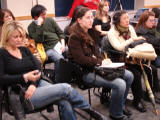
Flying a sensor on a plane or satellite and taking “photos” of the earth is a remarkably useful way for scientists to explore our dynamic planet. This process, called remote sensing, is one of the most efficient ways to detect large scale surface cover changes. My research demonstrates that Synthetic Aperture Radar (SAR), a very versatile type of remote sensing, can be used to assess natural disasters involving terrain resurfacing such as landslides, volcanic eruptions and fires. These hazards often temporarily remove a natural vegetation cover and, in doing so, modify the physical properties of the land surface. SAR has operational advantages over optical sensors for rapid disaster assessment because of its day/night acquisition capability; its ability to “see through” smoke, clouds and dust; and its side-looking viewing geometry, which is an advantage whenever data collection directly above the site would prove dangerous.


Online Notes
Natural Hazards Revisited

